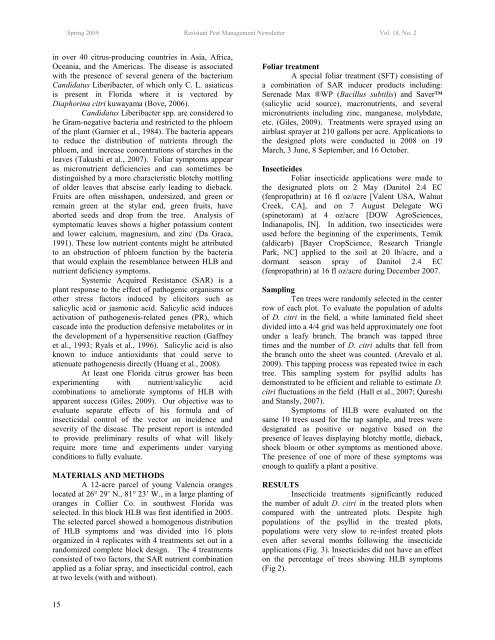Vol.18_No.2 - Pesticide Alternatives Lab - Michigan State University
Vol.18_No.2 - Pesticide Alternatives Lab - Michigan State University
Vol.18_No.2 - Pesticide Alternatives Lab - Michigan State University
You also want an ePaper? Increase the reach of your titles
YUMPU automatically turns print PDFs into web optimized ePapers that Google loves.
Spring 2009 Resistant Pest Management Newsletter Vol. 18, No. 2<br />
in over 40 citrus-producing countries in Asia, Africa,<br />
Oceania, and the Americas. The disease is associated<br />
with the presence of several genera of the bacterium<br />
Candidatus Liberibacter, of which only C. L. asiaticus<br />
is present in Florida where it is vectored by<br />
Diaphorina citri kuwayama (Bove, 2006).<br />
Candidatus Liberibacter spp. are considered to<br />
be Gram-negative bacteria and restricted to the phloem<br />
of the plant (Garnier et al., 1984). The bacteria appears<br />
to reduce the distribution of nutrients through the<br />
phloem, and increase concentrations of starches in the<br />
leaves (Takushi et al., 2007). Foliar symptoms appear<br />
as micronutrient deficiencies and can sometimes be<br />
distinguished by a more characteristic blotchy mottling<br />
of older leaves that abscise early leading to dieback.<br />
Fruits are often misshapen, undersized, and green or<br />
remain green at the stylar end, green fruits, have<br />
aborted seeds and drop from the tree. Analysis of<br />
symptomatic leaves shows a higher potassium content<br />
and lower calcium, magnesium, and zinc (Da Graca,<br />
1991). These low nutrient contents might be attributed<br />
to an obstruction of phloem function by the bacteria<br />
that would explain the resemblance between HLB and<br />
nutrient deficiency symptoms.<br />
Systemic Acquired Resistance (SAR) is a<br />
plant response to the effect of pathogenic organisms or<br />
other stress factors induced by elicitors such as<br />
salicylic acid or jasmonic acid. Salicylic acid induces<br />
activation of pathogenesis-related genes (PR), which<br />
cascade into the production defensive metabolites or in<br />
the development of a hypersensitive reaction (Gaffney<br />
et al., 1993; Ryals et al., 1996). Salicylic acid is also<br />
known to induce antioxidants that could serve to<br />
attenuate pathogenesis directly (Huang et al., 2008).<br />
At least one Florida citrus grower has been<br />
experimenting with nutrient/salicylic acid<br />
combinations to ameliorate symptoms of HLB with<br />
apparent success (Giles, 2009). Our objective was to<br />
evaluate separate effects of his formula and of<br />
insecticidal control of the vector on incidence and<br />
severity of the disease. The present report is intended<br />
to provide preliminary results of what will likely<br />
require more time and experiments under varying<br />
conditions to fully evaluate.<br />
MATERIALS AND METHODS<br />
A 12-acre parcel of young Valencia oranges<br />
located at 26° 29‟ N., 81° 23‟ W., in a large planting of<br />
oranges in Collier Co. in southwest Florida was<br />
selected. In this block HLB was first identified in 2005.<br />
The selected parcel showed a homogenous distribution<br />
of HLB symptoms and was divided into 16 plots<br />
organized in 4 replicates with 4 treatments set out in a<br />
randomized complete block design. The 4 treatments<br />
consisted of two factors, the SAR nutrient combination<br />
applied as a foliar spray, and insecticidal control, each<br />
at two levels (with and without).<br />
Foliar treatment<br />
A special foliar treatment (SFT) consisting of<br />
a combination of SAR inducer products including:<br />
Serenade Max ®WP (Bacillus subtilis) and Saver<br />
(salicylic acid source), macronutrients, and several<br />
micronutrients including zinc, manganese, molybdate,<br />
etc. (Giles, 2009). Treatments were sprayed using an<br />
airblast sprayer at 210 gallons per acre. Applications to<br />
the designed plots were conducted in 2008 on 19<br />
March, 3 June, 8 September, and 16 October.<br />
Insecticides<br />
Foliar insecticide applications were made to<br />
the designated plots on 2 May (Danitol 2.4 EC<br />
(fenpropathrin) at 16 fl oz/acre [Valent USA, Walnut<br />
Creek, CA], and on 7 August Delegate WG<br />
(spinetoram) at 4 oz/acre [DOW AgroSciences,<br />
Indianapolis, IN]. In addition, two insecticides were<br />
used before the beginning of the experiments, Temik<br />
(aldicarb) [Bayer CropScience, Research Triangle<br />
Park, NC] applied to the soil at 20 lb/acre, and a<br />
dormant season spray of Danitol 2.4 EC<br />
(fenpropathrin) at 16 fl oz/acre during December 2007.<br />
Sampling<br />
Ten trees were randomly selected in the center<br />
row of each plot. To evaluate the population of adults<br />
of D. citri in the field, a white laminated field sheet<br />
divided into a 4/4 grid was held approximately one foot<br />
under a leafy branch. The branch was tapped three<br />
times and the number of D. citri adults that fell from<br />
the branch onto the sheet was counted. (Arevalo et al.<br />
2009). This tapping process was repeated twice in each<br />
tree. This sampling system for psyllid adults has<br />
demonstrated to be efficient and reliable to estimate D.<br />
citri fluctuations in the field (Hall et al., 2007; Qureshi<br />
and Stansly, 2007).<br />
Symptoms of HLB were evaluated on the<br />
same 10 trees used for the tap sample, and trees were<br />
designated as positive or negative based on the<br />
presence of leaves displaying blotchy mottle, dieback,<br />
shock bloom or other symptoms as mentioned above.<br />
The presence of one of more of these symptoms was<br />
enough to qualify a plant a positive.<br />
RESULTS<br />
Insecticide treatments significantly reduced<br />
the number of adult D. citri in the treated plots when<br />
compared with the untreated plots. Despite high<br />
populations of the psyllid in the treated plots,<br />
populations were very slow to re-infest treated plots<br />
even after several months following the insecticide<br />
applications (Fig. 3). Insecticides did not have an effect<br />
on the percentage of trees showing HLB symptoms<br />
(Fig 2).<br />
15








